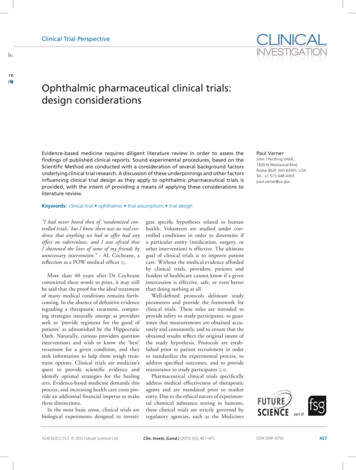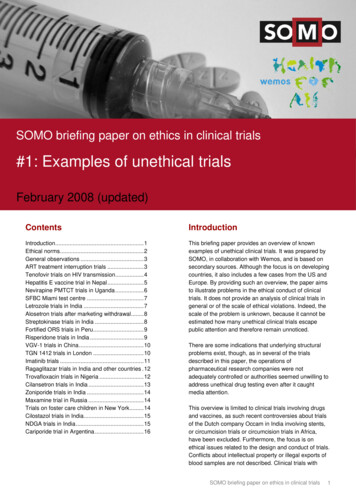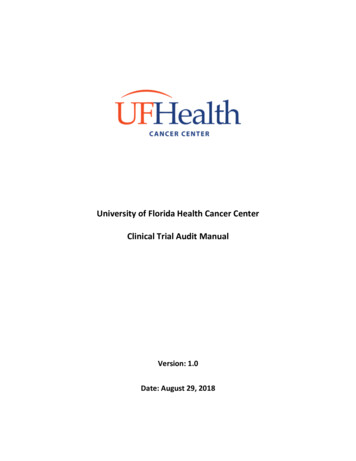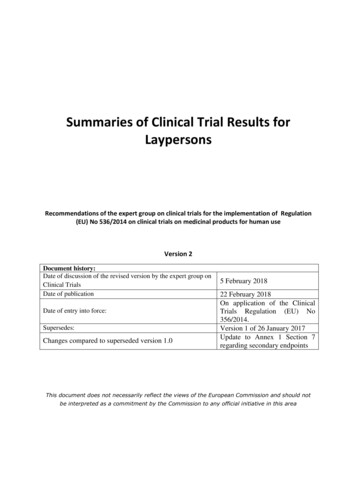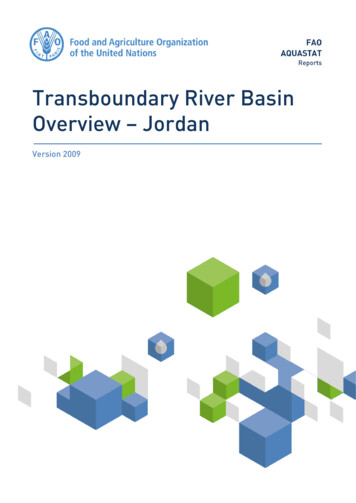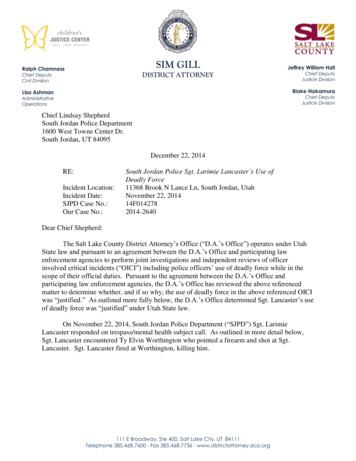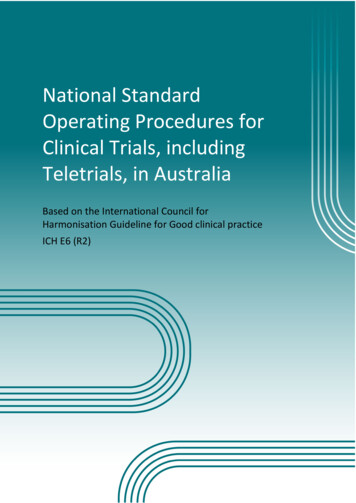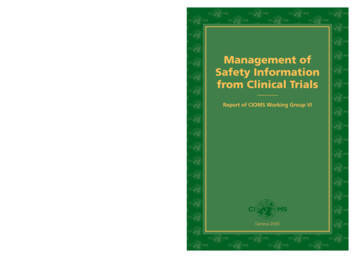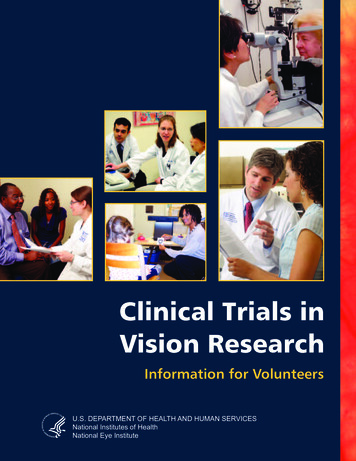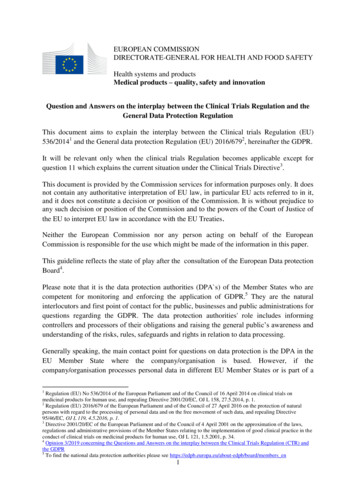
Transcription
CLINICAL TRIALSIN JORDAN:Current Statusand ImprovementOpportunitiesPEER REVIEWED Emad Y. Shafout, RN, CCRA Saleem Al Mahrouq, MSc[DOI: 10.14524/CR-14-0038]Performing research under conditions of robustmethodology is key for the development of new drugsand medical devices. However, the conduct of clinicaltrials within countries in the Middle East and NorthAfrica (MENA) is not yet optimal. Even though MENApopulations represent 9% of the world population,1 in2012, MENA countries, excluding Israel, hosted onlyapproximately 0.4% of global clinical trial sites andpatients.1In the mid-1990s, clinical trials started to gainrecognition in Jordan, one of the MENA countries, witha very limited number and types of trials. A decadelater, Jordan was recognized as one of the importantresearch sites in the MENA area. Several contractresearch organizations (CROs) were established therein the early 2000s, focusing solely on bioequivalenceand bioavailability studies.2Clinical Researcher71There are several reasons for the recognitionJordan has earned, including its highly qualifiedhealthcare professionals and well-establishedand accredited healthcare organizations. It is areferral country, with regional healthcare centersreceiving patients from all surrounding countriesin the region as they seek advanced medicaltreatment. Further, the country features highbioethical standards, resources availability, anda supportive regulatory body. This environmentfosters a heterogeneous patient population withvarious ethnic and cultural origins, which is idealfor clinical trials.Concerning clinical trials, Jordanian law doesnot distinguish between the different kinds ofpharmaceutical studies, even though there areclear definitions for therapeutic vs. nontherapeutictrials. This article reviews mainly Phase I to PhaseIV clinical trials.December 2014
FIGURE 1: Number of Trials in Selected CountriesFIGURE 4: Health Research Priorities 2009-2012961Denmark (5,540,241)512Finland (5,366,100)451Norway (4,896,700)425Slovakia (5,426,645)401Singapore (4,987,600)277Ireland (4,459,300)68Lebanon (4,255,000)45Jordan (6,472,000) Number of Trials (Phase I-IV) 2010-2013 (ClinicalTrials.gov)*World Atlas.comFIGURE 2: Top Ten Causes of Death for 2010 According to ICD-10Circulatory systemNeoplasmsExternal causesEndocrine, nutritional, and metabolic disordersPerinatal periodRespiratory systemCongenital malformationsS&S not elsewhere classifiedDigestive systemGenitourinary systemPERCENT 05101520253035Source: MoH, Directorate of Information and Research, Mortality Data, Issue Dated May 1, 2011FIGURE 3: Insurance Distribution 2010MoHMilitary/RoyalMedical s2%Others3Reproductive Health4Health Behavior: smoking, dietary habits, drug abuse, etc.5Health System and Health Policy6Environmental Health7Communicable Diseases: hepatitis B and C, respiratoryinfections, diarrheal diseases, etc.8Demographic Transitions9Oral HealthDEMOGRAPHICS62Georgia (4,436,000)2Noncommunicable Diseases: cardiovascular, cancers,injuries, endocrine, obesity, osteoporosis, and neuropsychiatricMaternal and Child Health: prenatal and nutritionaldeficiencies1Country (Population)*1%*United Nations Relief and Works Agency for Palestine Refugees in the Near East.Source: High Health Council and Directorate of General Statistics, Medical Insurance and Payment, Issue Dated September 2011December 20147240The estimated population of Jordan at the end of2012 was 6,388,000, with an annual growth rate of2.2%. Approximately 60% of the Jordanian population are between 15 and 64 years old, and the lifeexpectancy of the country’s citizens is 73 years.3Despite the fact that the Jordanian populationis small, sponsors and clinical trial stakeholdersrecognize the research potential of Jordan. Figure1 presents details on clinical trial activity and population in a selection of countries with a similar orsmaller population than that of Jordan.The most common cause of death in Jordan iscirculatory disease, such as ischemic heart disease,cerebrovascular disease, hypertension, and heartfailure. The top 10 causes of death in the country,according to the International Classification ofDiseases (ICD-10) in 2010, are shown in Figure 2.4The Jordanian health system is highlyacclaimed, including primary and advancedhealthcare services. Further, approximately 70% ofthe Jordanian population has healthcare insurance(Figure 3 demonstrates the distribution of insurance for the Jordan population).3Circumstances related to the causes of death,management of the healthcare system, and availability of insurance in Jordan have had an impactin identifying research priorities. The Ministry ofHealth/Directorate of Information and Researchhas identified the “National Health Research Priorities 2009–2012,” which has shown that noncommunicable diseases have the highest priority, whileoral health has the lowest (see Figure 4).4Although Arabic is Jordan’s official language, allsource documents are in English, including medicalnotes, progress notes, laboratory results, radiologyreports, and medication prescriptions. English isthe primary language of education for all healthcareprofessions, including medicine, dentistry, nursing,pharmacy and pharmacology, and rehabilitationsciences. However, patient materials such as questionnaires and consent forms should be in Arabic.Clinical Researcher
TYPE AND STATUS OF STUDIESThe number of clinical trials in the MENA regionremains very low compared to the United States,Canada, Europe, and most of the Asian countries.However, Jordan is a leading country in the regionin this field, especially in bioequivalence andbioavailability studies.5 The approximate numberof these studies submitted between 2005 and 2013was 1,470 studies (for registered and unregisteredproducts). Of these and the 135 Phase I–IV studiesconducted between 2005 and 2013, only six wererejected, while the rest were approved or receivedat least conditional approval.2The first registered clinical trial under theJordan Food and Drug Administration (JFDA) wasinitiated in 2001. In 2010, there were 34 clinicaltrials: 19 Phase I and the rest Phase II to IV. In 2014,up to early October, there were 26 clinical trialssubmitted (four Phase IV and 22 Phase I to III).2The main sources of clinical trials coming toJordan are global pharmaceutical companies fromEurope and the U.S., in addition to a few studiesfrom U.S. biotechnology companies. Most of thesestudies were conducted in collaboration withregional or global CROs.2To date, the most common phase of clinicalstudies conducted in Jordan is Phase III, followedby Phase IV. Although pediatric and medicaldevice studies are permitted, there is no significantincrease to the total from the number of studiesconducted in these areas.2 Figure 5 shows thenumber and type of submitted studies per yearfrom 2005 to 2013, as well as the approved numberof studies vs. rejected or conditionally approvedstudies. Figure 5 also shows the distribution ofclinical trials according to therapeutic areas.2REGULATORYThe highest governing body of all types of clinicaltrials in Jordan is the Ministry of Health (MoH)/JFDA, which was established in 2003. By late 2004,the clinical studies division was initiated.JFDA plays a very important role in the protection of the rights and safety of participants and inmaintaining a high level of ethical standards throughcontinuous visits, inspections, and monitoring ofclinical sites and institutional review boards (IRBs).In addition, JFDA is responsible for training andmaintaining an increased awareness of researchamong healthcare professionals and the publicthrough educational meetings and conferences.FIGURE 5B: Total Number of Studies from 2005 to September 010175142011145162012153182013180262014 Total Phase I-IV180 BioequivalenceFIGURE 5C: Number of Phase I-IV Studies per Therapeutic Area 2005-201319Phase IVPhase IIIPhase II12Phase 20112012765743020132014*Only one study in 2014 was first-in-humans; the rest were drug-drug interaction and pharmacokinetics.FIGURE 5D: Number of Phase I-IV Studies per Therapeutic Area ric16%Diabetes and Metabolic15%Blood/Immunology/InflammationFIGURE 5A: Approved vs. Rejected Studies ve87.7% ApprovedInfectious Disease0.3% Rejected12% Conditional ApprovalClinical Researcher734%Gynecology2%Respiratory2%December 2014
FIGURE 6: Significant Milestones in Clinical Trial Regulations in Jordan2001 Temporary lawNo. 67The CSC has all therequired powers tocarry out its mission,especially since it wasformed according toJordanian law.2003 JFDA established Temporary lawamended (No. 44)20042005 ClinicalStudies Divisionestablished Database for theparticipant inbioequivalencestudies launchedIn 2004, the JFDA created the Clinical StudiesCommittee (CSC) to be responsible for reviewingand issuing approval or rejection for submittedstudies. This committee is the highest authority forthe initial decision on any new or ongoing study inhuman subjects.The CSC has all the required powers to carry outits mission, especially since it was formed accordingto Jordanian law. Headed by the JFDA GeneralDirector, the committee includes the JFDA Directorof Drug Directorate, the JFDA Head of the ClinicalStudies Division, a pharmacist from the Drug Directorate, a clinician from the MoH, a clinician fromthe Physicians Labor Board, a member from theRoyal Medical Services (military), and five representatives from academic and private institutions.The committee also has the right to consult externalspecialists as needed.Healthcare research is now recognized andsupported by governmental and private agencies,and Jordan is a leading country in clinical trialslegislation in the Arab world. A temporary lawissued in 2001 became permanent in early 2011; thatlaw states that all clinical trials in Jordan shouldadhere to the Declaration of Helsinki as confirmedin Article 11. The law also specifies that one of themain duties for all local ethics committees is toensure that the research team is able to conductthe study according to, and in adherence to, goodclinical practice (GCP) guidelines (Article 8-a-2).Per Article 13-d, one of the main responsibilities ofthe CSC is to ensure that all licensed facilities forclinical trials adhere to GCP and good laboratorypractice guidelines.6However, the Jordanian law is currently writtenusing wide and vague statements that are open toindividual interpretations. Clearly written specificdetailed guidelines or requirements would be ofgreat benefit to all stakeholders. Since 2001, JFDAhas issued more than 55 supportive memos, guidelines, and requirements to organize and improvethe submission process, monitoring, and reporting.The most important examples of such memos andguidelines concern investigational drug labelingrequirements and investigators’ qualifications.December 2014201074 Import/exportrequirements identified Study drug labelrequirement Start biannual trainingprogram for clinicalresearch professionals Insurance requirements2011 Permanent lawapproved and issued Principal investigatorqualificationsidentifiedFigure 6 illustrates some important steps inclinical trials regulation. All these additions aremade available in separate documents, but itis highly recommended that the documents bemerged (including all clarifications), so that sponsors can consider all of the requirements together,rather than reviewing each individual memo fromover the years.SUBMISSION AND REVIEWThe expected time from full protocol packagesubmission to final approval for conduct of a trialas estimated by JFDA is four to six weeks for PhaseI–III studies, if there are no comments or additionalrequirements requested.7 Otherwise, the approvaltime will vary based on the nature of the comments or requirements as well as on the sponsor’sfeedback. Next, the sponsor seeks approval from anIRB/ethics committee, based on any new requirements and with a commitment of adherence tothem by the principal investigator and the sponsor.However, if the sponsor does not reply to theboard’s/committee’s feedback regarding furtherchanges that may be requested within six months,the application will be considered withdrawn.One of the main issues for clinical studies inJordan is the time the studies take to get approved;this has a negative impact on patient recruitmentand study progress, and means that any eventualapproval of a new drug or device is delayed. Therefore, the current submission procedures shouldbe reviewed and more time-efficient strategiesdeveloped.One issue of timeliness is that, currently, JFDAuses the sequential submission system as describedwhere and does not accept parallel submission atthe same time as IRB/ethics committee submission.Electronic submission is definitely a good approachfor improving the submission process, yet allsubmissions must be delivered by hand to the JFDAat this time. The use of electronic submissions willsave up to two to three weeks, with study documentsreaching CSC members directly and with externalreviewers facing no need to wait for the next meetingto receive materials for consideration.Clinical Researcher
JFDA plays a very important role inthe protection of the rights and safetyof participants and in maintaininga high level of ethical standardsthrough continuous visits, inspections,and monitoring of clinical sites andinstitutional review boards.FIGURE 7: Number of Licensed Facilities as of August 20143Private CROs45Private70University2230CLINICAL SITES AND IRBSAccording to Jordanian law, clinical trials can beconducted only at licensed sites; the same processapplies to all other involved facilities, including IRBs/ethics committees, safety labs, and analytical labs.As of 2012, Jordan had 106 hospitals with atotal capacity 12,106 beds.3 These hospitals can bedivided into four main categories: MoH hospitals,university hospitals, military hospitals (RoyalMedical Services), and private hospitals. Most ofthe private, military, and university hospitals areaccredited by one or more of the local or international accreditation bodies; they also have themost recent diagnostic and treatment equipment,use the Internet, and have no difficulties usingelectronic case report forms. In addition, thesehospitals have local laboratories and/or researchunits to facilitate lab samples processing as well asshipping to central labs if needed. However, lessthan 20% of Jordanian hospitals are licensed asclinical trials sites (see Figure 7).8Governmental and private hospitals need tomake greater efforts to become involved in clinicalstudies. Currently, only three of 31 MoH hospitalsare licensed for clinical trials; their physicians areinterested in being involved in trials, but manyissues—such as site facilities, medical documentation, and lack of experience and encouragement bytop management—need to be resolved in collaboration with the MoH, sponsors, and regulators.The military hospitals are well established andhave an advanced documentation system for usein clinical trials. However, the number of clinicaltrials conducted in these hospitals is very low, dueto the long time required to get IRB/ethics committee approval and contract negotiation. The topmanagement in such settings needs to encouragegreater interest and to establish research activitybenchmarks against similar institutions.Governmental34For private sites as well, sponsors and investigators should clarify to patients the benefits ofclinical trials, regardless of where they are treated,and healthcare workers should get more trainingand experience in clinical trials. Of the 18 licensedhospitals, only four have dedicated research unitsmanaging trials and providing the required logisticsupport to investigators.Jordan does not use a central ethics committee; only IRBs/ethics committees based withinindividual institutions are used. Each licensedclinical site must have such a body, which shouldbe approved by the JFDA. According to Jordanianlaw, the board/committee should consist of atleast five members from both sexes with sufficientexperience and competency.An IRB/ethics committee is required to includeat least one legal advisor in addition to a representative from the local community.6 Board/committee membership is valid only for two renewableyears.6 Figure 7 shows the number of approvedIRBs/ethics committees in Jordan.CONCLUSIONClinical trials are growing in the MENA region,and Jordan is a leading country in this area.Conducting a clinical trial in Jordan is protectedby the government via the Clinical Studies Lawand monitored by IRBs/ethics committees. Thehealthcare systems of the country are ready to bemore involved in clinical trials.All stakeholders must be willing to participatein clinical research, to provide more trainingand educational programs, and to develop morecreative solutions for facilitating and expeditingprotocol submission, review, and monitoring, suchas electronic submission, detailed guidelines for alltrial steps, and benchmarking. Also, governmentalhospitals require greater research awareness,training sessions, and improved support in termsof facilities, systems, and guidance.Clinical Researcher751211MilitaryThe sponsor can submit all documents inEnglish, except those for the patient (informedconsent form, information sheet, patient’s cards,questionnaires, diary cards, etc.), which should bein Arabic.9December 2014LaboratoriesIRBsClinical sitesAcknowledgmentOur deep thanks toKhalil M. Yousef, PhD,RN, from the Faculty ofNursing, University ofJordan, for his supportand help.Emad Y. Shafout, RN, CCRA,(emad.shafout@INCresearch.com) is a senior clinicalresearch associate for INCResearch.Saleem Al Mahrouq, MSc,is head of the Clinical StudiesDivision, Jordan Food andDrug Administration.References1. Misk V. 2012. ExpectedGrowth of IndustrySponsored ClinicalTrials in the Middle EastBenchmarked on OtherGlobal Regions. Whitepaper.2. Database and Registry ofClinical Studies Division,Jordan Food and DrugAdministration.3. Department of Statistics,Jordan Statistical Yearbook2012.4. Ministry of Health,Directorate of Informationand Research. 2011.Mortality data for 2010in Jordan. Mortality Dataissue May 1, 2011.5. www.ClinicalTrials.gov6. Clinical Studies Law 2011.7. AlMahrooq S. Jordan FDAApproval Process andTimelines. Conferencepresentation, 2nd annualPTC MENA.8. Jordan Food and DrugAdministration website.
The first registered clinical trial under the Jordan Food and Drug Administration (JFDA) was initiated in 2001. In 2010, there were 34 clinical trials: 19 Phase I and the rest Phase II to IV. In 2014, up to early October, there were 26 clinical trials submitted (four Phase IV and 22 Phase I to III).2 The main sources of clinical trials coming to
